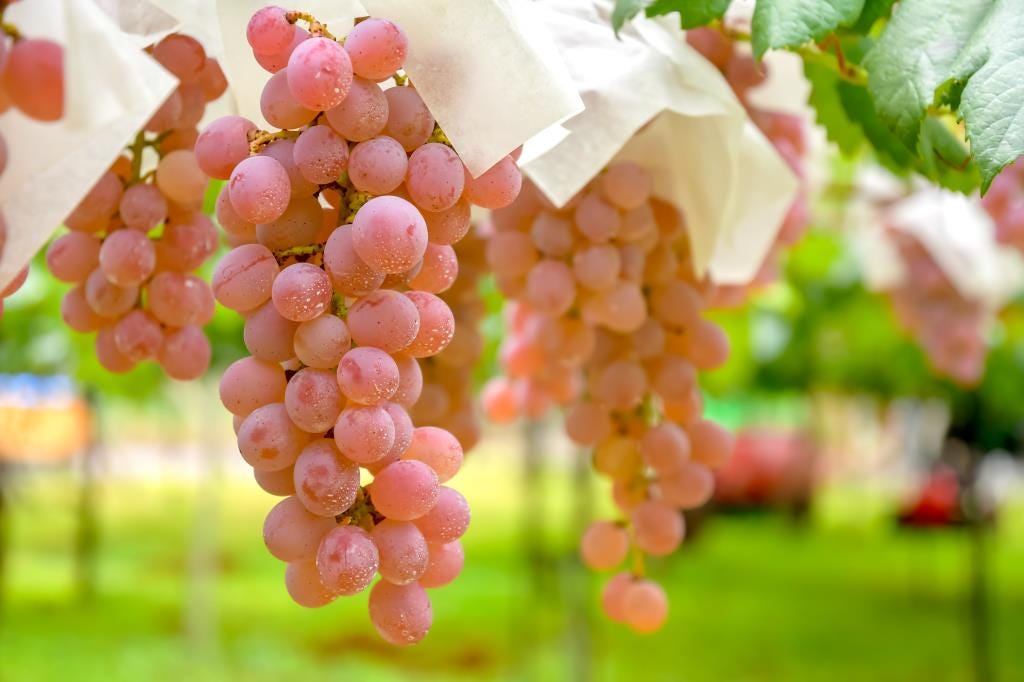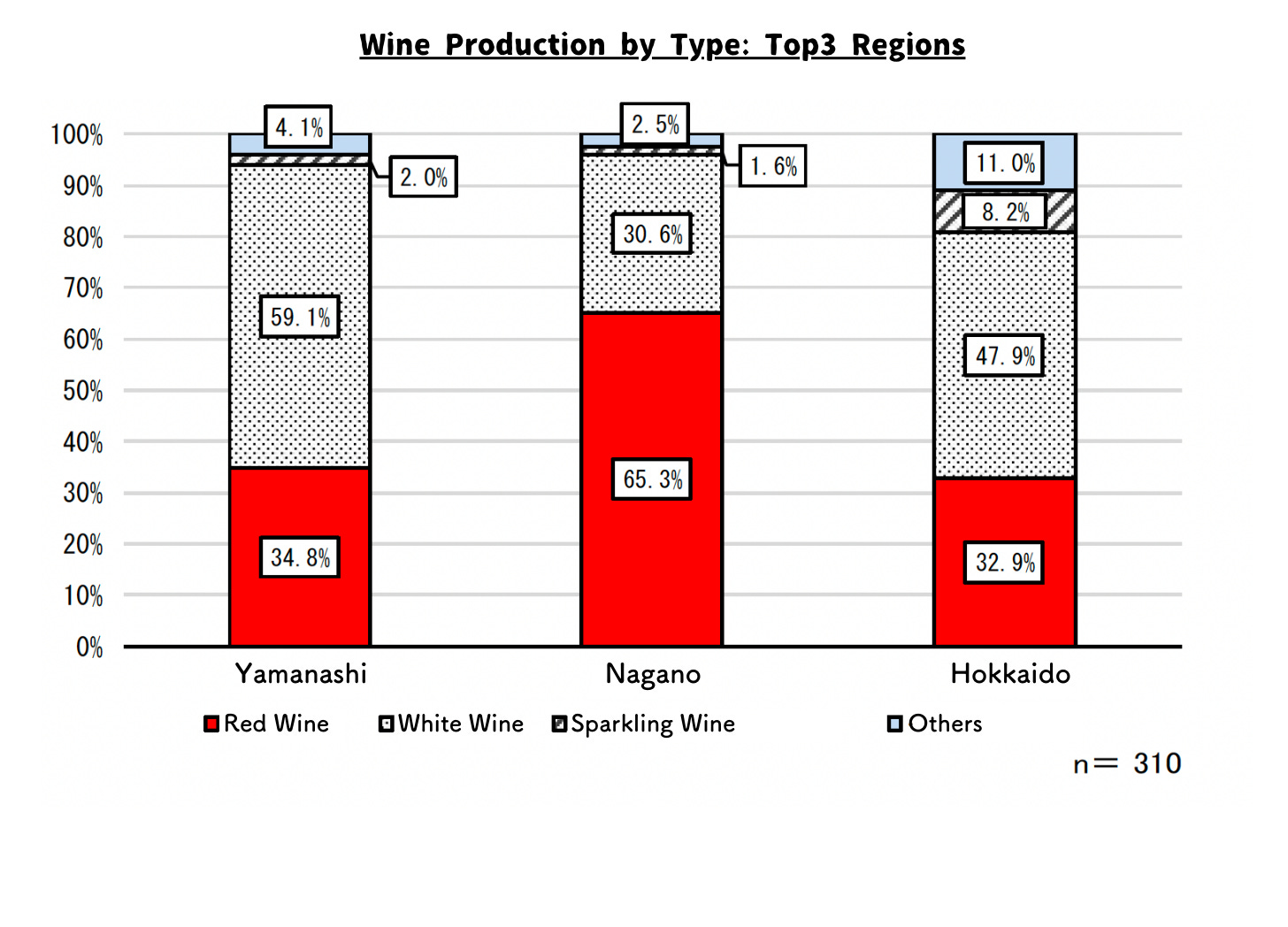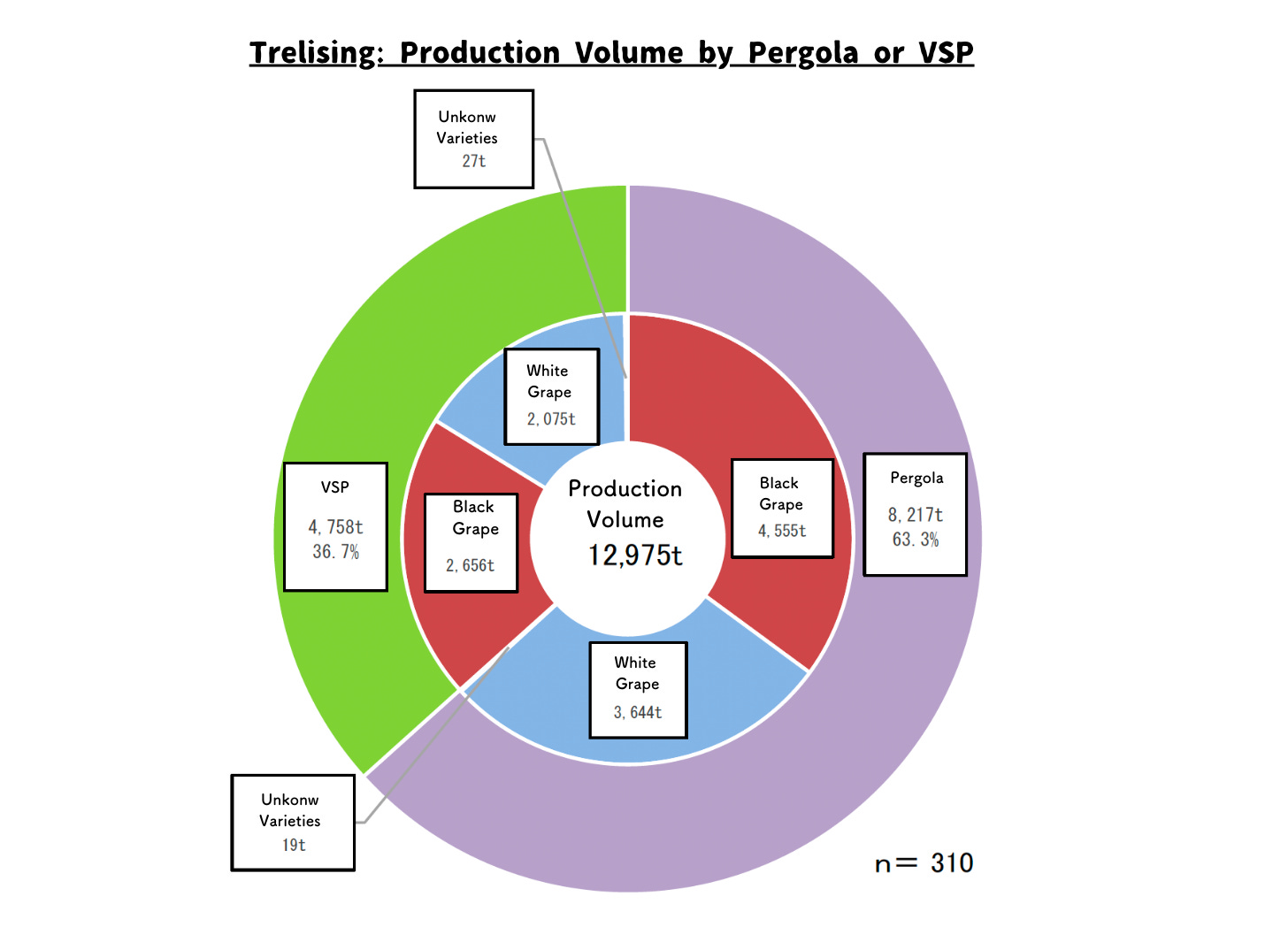The Hidden Elegance of Japanese Wine
An In-Depth Overview of Japanese Wine
Introduction
Recently, I shared a wine tasting note on one of Japan’s popular wines, the Albariño from Ajimu Winery in Oita Prefecture. The post sparked a range of responses, such as, “I’ve never tried Japanese wine, but it sounds interesting,” “I’d love to give it a try,” and even, “Do you make wine in Japan?” Inspired by these reactions, I decided to put together an overview of Japanese wine. (Japanese wine is wines made from grapes grown in Japan, which doesn’t include wines produced in Japan with imported ingredients.)
This information has been compiled using reliable sources, including data from the Japanese National Tax Agency (which oversees alcohol production in Japan) and the official websites of wine regions and producers. However, as I’m based in the Netherlands, I welcome corrections or additional insights from Japanese wine experts. I’ll quietly update this post as needed. Let’s dive in!
History
While records suggest that wine was made in Japan as early as the 8th, 12th, or 17th centuries, the modern history of Japanese wine began in the 19th century, during a period of rapid modernization and Western influence.
The pivotal figure in Japan’s winemaking history is Ryuken Tsuchiya, who, along with Masanari Takano, established the first vineyards in Katsunuma, Yamanashi Prefecture, in 1875. Inspired by Western winemaking, Tsuchiya traveled to France to study viticulture, bringing back essential knowledge that laid the foundation for Japan’s wine industry. In 1877, the Dainihon Yamanashi Budoshu Kaisha (Great Japan Yamanashi Wine Company) was founded, marking the official start of commercial wine production.
Although Japan’s humid climate and lack of suitable grape varieties presented significant challenges, these early efforts led to the development of hybrid grape varieties and improved winemaking techniques, paving the way for today’s thriving Japanese wine industry.
Major Wine Regions and Production Volume
Japan’s wine production is concentrated in a few key regions, each contributing unique characteristics to the country’s wine identity. As of 2021, there are 413 wineries in Japan, according to the National Tax Agency. The most prominent regions include:
Yamanashi Prefecture (92 wineries): Known as the birthplace of Japanese wine, Yamanashi accounts for about one-fourth of Japan’s total wine production. Its elevation and well-drained volcanic soils create ideal conditions for viticulture.
Nagano Prefecture (62 wineries): With its cool climate and diverse terroirs, Nagano has become a hub for premium wine production. Vineyards here are often located at altitudes of 600–1,200 meters.
Hokkaido (46 wineries): Japan’s northernmost region, Hokkaido, is recognized for its cold climate and long daylight hours during the growing season, which benefit international grape varieties.
Yamagata Prefecture (19 wineries): Known for its fertile soils and mountain-ringed valleys, Yamagata specializes in aromatic white wines and some reds.
Niigata Prefecture (10 wineries): This region is characterized by coastal vineyards and a humid summer climate, which influence its distinctive wine styles.
Climate and Soil
Japan’s wine-producing regions are primarily located between 35°N and 43°N, aligning with notable European wine regions like Bordeaux (45°N) and Rioja (42°N). However, unlike parts of Europe warmed by the Gulf Stream, Japan’s climate is more temperate. Additionally, its mountainous terrain creates diverse microclimates across the country.
Its climate is predominantly maritime, featuring high humidity, frequent rainfall, and moderate temperatures influenced by its proximity to the ocean. Annual rainfall averages around 1,500 mm, similar to Spain’s Rías Baixas, posing challenges in disease management. Additionally, late-summer typhoons can damage grapes nearing harvest, making early-ripening or disease-resistant varieties essential.
Amongst other regions, Yamanashi is one of the driest regions, with 700mm up to 1000mm of rainfall during the growing season, thanks to its mountainous terrain, serving as a rain shadow. Hokkaido is even with its continental climate resembling Germany’s Mosel Valley. Also, So, again, microclimates are important.
Soil Types
Japan has volcanic soils in many area, due to the country’s active volcanic activity, provide excellent drainage and a rich mineral profile. These soils are particularly prominent in wine regions like Yamanashi and Nagano.
Grape Varieties and Production Volumes
Japanese winemakers grow a mix of native, hybrid, and international grape varieties, each adapted to the country’s unique climate.
Production Volumes by Grape Varieties
Native and Hybrid Varieties
Koshu: Koshu is Japan’s signature white grape variety, primarily grown in Yamanashi Prefecture. Known for its light, crisp character, it is often vinified in the Sur Lie style, so which can occasionally be mistaken for Muscadet Sur Lie. Koshu’s thick skin makes it particularly well-suited to Japan’s humid climate. When fully ripe, the grape bunches develop a delicate, elegant pink hue reminiscent of sakura (cherry blossoms), a beloved symbol of Japanese culture. Genetic analysis has revealed that Koshu is actually a Vitis vinifera variety, with links to ancient Caucasian strains, making it one of the oldest domesticated vines.
Muscat Bailey A: Developed in the early 20th century by Zenbei Kawakami, this hybrid grape is a cross between Vitis vinifera and Vitis labrusca. It was specifically bred to withstand Japan’s humid climate and is known for producing soft, fruity wines. Widely cultivated in Nagano and Yamanashi, Muscat Bailey A is often vinified using carbonic maceration, which enhances its vibrant, fruity profile.
International Varieties
Merlot: Thrives in Nagano’s cooler climate, producing structured, age-worthy wines.
Chardonnay: Grown successfully in Hokkaido and Nagano, offering wines with balanced acidity and fruit.
Cabernet Sauvignon: Though challenging to grow due to humidity, it is cultivated in select areas with careful vineyard management. But, when it’s succeeded, the result is worth trying.
Pinot Noir: Gaining popularity in Hokkaido, where the cool climate supports its delicate nature.
Notably, Chardonnay and Pinot Noir from Hokkaido, Koshu from Yamanashi, and Merlot from Nagano have received international recognition the most.
Not Just About Wine
This isn’t just a story about wine, but did you know about the Japanese passion for creating the finest fruits? This passion is often artistic, meticulous, and extraordinary. For instance, when you visit a department store in Japan, you might see a single strawberry presented in an opulent box, priced at 50 euros for just one piece. This reflects a deep cultural appreciation for perfection and craftsmanship. Historically, Japanese viticulture also has been more focused on producing exceptionally high-quality table grapes rather than wine, with viticulture for winemaking taking a more marginal role.
Grape Growing
Let’s dive back into story for wine. In Japan, the pergola system is widely used, much like in Rías Baixas, to improve airflow and reduce the risk of fungal diseases in the humid climate. Additionally, farmers often go the extra mile by creating individual umbrellas for grape bunches to shield them from rain. This level of meticulous care reflects the Japanese spirit of craftsmanship, described as "world-class" by a prominent winemaker.
Advances in research and technology have also led to the adoption of modern training systems, such as VSP (Vertical Shoot Positioning), which has become increasingly prevalent in Japanese vineyards. These modern approaches are paving the way for greater consistency and quality in Japanese winemaking, complementing the traditional methods still in use.
Wineries to Explore
Here are a few notable Japanese wineries whose wines you can find outside of Japan:
Chuo Budoshu (Grace Wine)
Based in Yamanashi Prefecture, this winery specializes in high-quality Koshu wines that have garnered international recognition.
Official Website
Last year, I had the opportunity to attend a masterclass led by winemaker Ayana Misawa. You can read more about it here.Château Mercian
A premium brand under Mercian, producing wines from vineyards in Nagano and Yamanashi Prefectures.
Official WebsiteDomaine Takahiko
A boutique winery in Yoichi, Hokkaido, renowned for natural wines made using biodynamic and organic methods. Its Pinot Noir and Chardonnay have become so sought-after that they’re often hard to find in Japan but can sometimes be discovered in specialty shops abroad, like in Sweden.
Official WebsiteSuntory Tomi no Oka Winery
Located in Yamanashi Prefecture, this winery produces high-quality wines with global acclaim, including in some competitions.
Official Website
Conclusion
Japanese wines are often described as light, nuanced, subtle, and elegant—qualities that stand in contrast to the minerality, power, and structure commonly associated with wines from traditional or New World wine regions. While some may find Japanese wines almost too gentle, this very subtlety makes them the perfect companion to the refined and nuanced flavors of Japanese cuisine.
Since the mid-2000s, Japanese cuisine has become one of the most celebrated global food trends, reaching every corner of the world. Whether authentic or creatively reimagined, sushi has become an extraordinary ambassador of Japanese culture, alongside its food and beverages. This culinary subtlety and elegance have naturally sparked growing interest in complementary drinks like sake and wine.
Japanese wine, although still a smaller player in the global market, is increasingly recognized as an extension of Japan’s culinary artistry. The meticulous care and dedication found in Japanese winemaking reflect the same precision that defines its cuisine. With its growing reputation, Japanese wine offers a unique opportunity for enthusiasts to experience a culture where craftsmanship, artistry, and a deep respect for nature converge in every bottle.
So why not try a bottle and discover the delicate harmony of Japanese wine for yourself?
日本の方の時間短縮のため、ChatGPTで翻訳しました。英語版に比較して、消されている部分があるので、全文を読みたい場合は翻訳ツールをご活用ください。
日本ワインの世界
はじめに
先日、大分県の安心院ワイナリーが手掛ける人気ワイン「アルバリーニョ」のテイスティングノートを紹介した。この投稿には、「日本ワインを試したことはないけれど興味深い」「飲んでみたい」さらには「日本でワインなんて作っているのか」といった反応が寄せられた。これをきっかけに、日本ワインについての概要をまとめることにした。(ここでの日本ワインとは、日本国内で栽培されたブドウを使用して作られたワインを指し、輸入原料を使ったものは含まない。)
この記事は、国税庁やワイン産地・生産者の公式サイトなど、信頼できる情報源を基に構成している。筆者はオランダ在住のため、日本ワインの専門家からの補足や訂正を歓迎する。
歴史
日本でのワイン造りは、8世紀や12世紀、または17世紀に始まったとされるが、近代的な日本ワインの歴史は19世紀に西洋文化の影響を受けて本格化した。1875年、山梨県勝沼で土屋竜憲と高野正誠が初めてのブドウ畑を設立したことが、現代日本ワインの礎となっている。土屋はフランスでワイン造りを学び、その知識を持ち帰ることで日本初の商業ワイン生産が実現した。1877年には「大日本山梨葡萄酒会社」が設立され、これが商業生産の正式な始まりとなる。
日本の多湿な気候や適したブドウ品種の不足といった課題にもかかわらず、これらの初期の努力がハイブリッド品種の開発や製造技術の進化を促し、現在の日本ワイン産業の基盤を築いている。
主要産地と特徴
日本国内には413のワイナリーがあり、特に以下の地域が重要な産地となっている:
山梨県:国内生産の約25%を占める日本ワイン発祥の地。標高の高さと火山性土壌が、ブドウ栽培に最適な条件を提供している。
長野県:冷涼な気候と多様なテロワールを有し、プレミアムワインの生産地として注目されている。畑は標高600~1,200メートルの場所に多く存在する。
北海道:最北端の地域で、冷涼な気候と長い日照時間が特徴。ピノ・ノワールやシャルドネなど、国際品種の栽培に適している。
山形県:肥沃な土壌と山々に囲まれた谷間が特徴で、香り豊かな白ワインや一部の赤ワインの生産が盛んである。
新潟県:沿岸部に位置し、湿度の高い夏の気候が独自のワインスタイルを生み出している。
日本のブドウ品種と栽培技術
甲州:日本固有の白ブドウ品種で、山梨県で主に栽培されている。軽やかで繊細な味わいが特徴で、湿度の高い日本の気候に適応している。完熟すると、桜の花を思わせるような淡いピンク色を呈する。
マスカット・ベーリーA:1920年代に川上善兵衛によって開発されたハイブリッド品種で、果実味豊かな赤ワインを生み出す。長野県や山梨県で広く栽培されており、特にカーボニック・マセレーションでの醸造が多い。
湿度対策として棚仕立て(パーゴラ)を採用し、さらに雨よけとしてブドウ房ごとに傘をかけるなど、農家は細部までこだわった栽培技術を実践している。この手間を惜しまない姿勢は「世界に誇る日本の職人技」とも評されている。
気候と土壌
日本のワイン産地は北緯35度から43度に位置し、ヨーロッパの主要ワイン産地に近いが、多湿な気候や高い降水量が特徴である。年間降水量は1,500mmに達し、スペインのリアス・バイシャス地方に似た条件が課題となる一方で、鮮やかな酸味を生む要因にもなっている。
日本の火山性土壌は排水性に優れ、ミネラル分が豊富である。特に山梨県や長野県では、この土壌がブドウ栽培にとって重要な役割を果たしている。
代表的なワイナリー
グレイスワイン(中央葡萄酒):山梨県を拠点とし、甲州を用いた高品質ワインで国際的評価を得ている。公式サイト
シャトー・メルシャン:長野県と山梨県のブドウを使用し、国内外で評価されるプレミアムワインを生産。公式サイト
ドメーヌ・タカヒコ:北海道余市に位置し、自然派ワインを生産するブティックワイナリー。特にピノ・ノワールとシャルドネが評価されている。公式サイト
結論
日本ワインは軽やかで繊細、そしてエレガントな味わいが特徴であり、従来のワイン産地や新世界のワインのような力強いスタイルとは一線を画している。この繊細さは、日本料理の上品な味わいと見事に調和する。寿司を中心とした日本料理が2000年代以降、世界的な人気を博し、日本酒やワインといった関連飲料への関心も高まりつつある。
まだ規模は小さいものの、日本ワインはその職人技と自然への敬意で国際市場における存在感を増している。日本料理と同じように、丁寧に作られた一瓶を通じて、その文化と美学を感じる機会をぜひ楽しんでほしい。
日本ワイン、日本酒について(オランダから)欧州向けのプロモーションお手伝いをしていきたいと思っています。ご相談はメールアドレス(kazumi.uejoアットマークgmail.com)までご連絡ください。











Thank you so much for this post! Maybe just to add that some Japanese wines, such as Hokkaido are protected in the EU as geographical indications through the EU-Japan FTA
See here: https://www.tmdn.org/giview/gi/search
I also knew nothing about Japanese wines! Thanks for enlightening us, Kazumi 😊